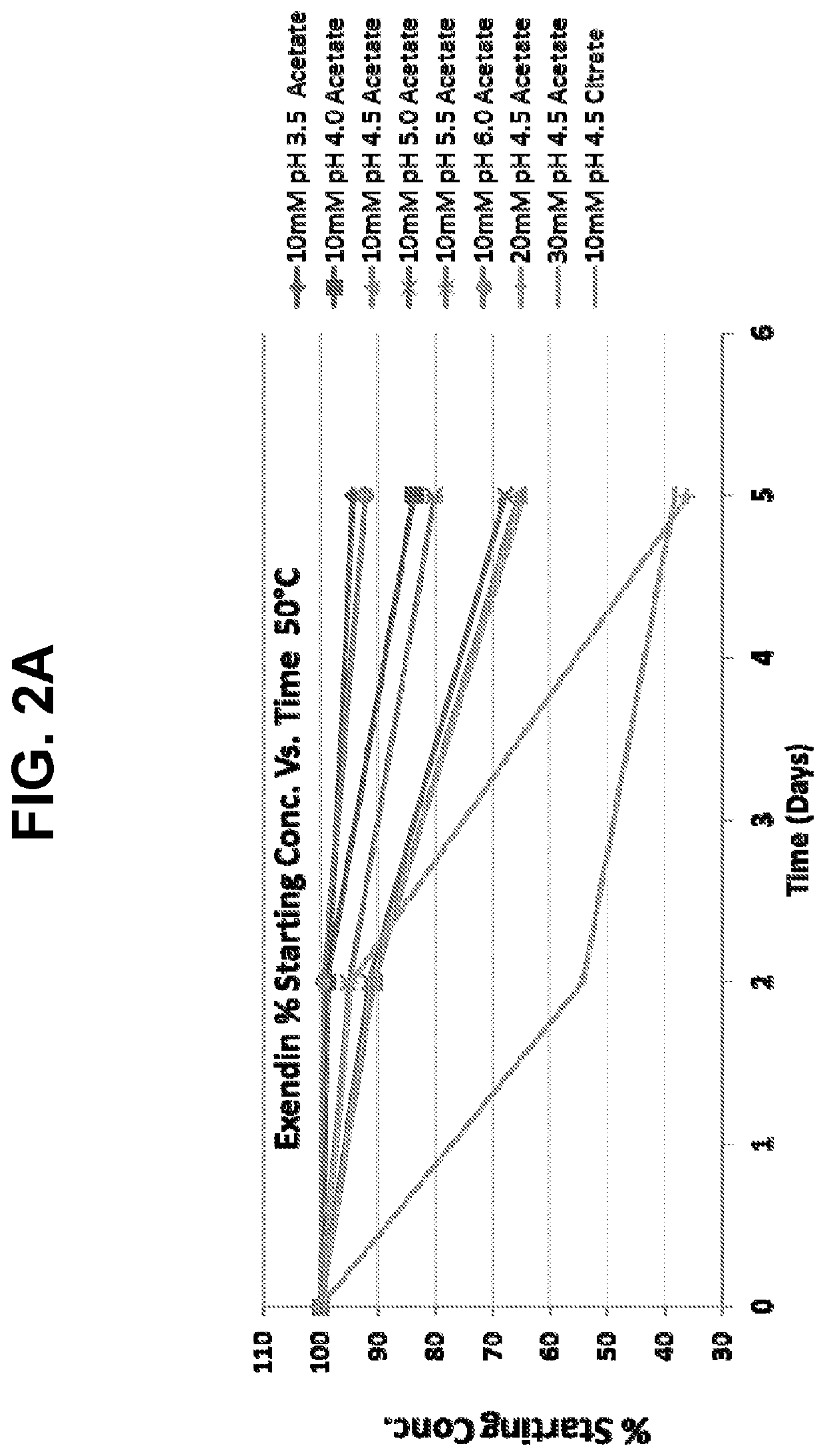Buffered Formulations Of Exendin (9-39)
a technology of exendin and formulation, which is applied in the field of improved pharmaceutical formulations of exendin (939), can solve the problems of seizures, brain damage and death, and achieve the effects of preventing hyperinsulinemic hypoglycemia, improving pharmacokinetic profile, and reducing toxicity
- Summary
- Abstract
- Description
- Claims
- Application Information
AI Technical Summary
Benefits of technology
Problems solved by technology
Method used
Image
Examples
example 1
s of Reconstituted Exendin (9-39) in 0.9% Normal Saline and Buffered Exendin (9-39) Formulations
[0111]This example describes physical and chemical properties of lyophilized exendin (9-39) acetate reconstituted in 0.9% normal saline as compared to the properties of buffered formulations of exendin (9-39).
Properties of Exendin (9-39) Formulated in Normal Saline
[0112]Different concentrations (5, 10.24, 15.3, 25.22, and 44.99 mg / ml) of lyophilized exendin (9-39) acetate were prepared by reconstituting in 0.9% normal saline and stored at 5° C. The pH of each reconstituted exendin (9-39) formulation was recorded at day zero and monitored for up to 14 days. All concentrations of the reconstituted exendin (9-39) formulations resulted in an initial pH of 4.4 to 4.5. A visual inspection of each reconstituted exendin (9-39) formulation was also noted on day zero and monitored for up to 14 days, while being held at 5° C. The results are shown in Table 1 below. No aggregation, gelling or precipi...
example 2
ncentration Profile of Buffered Exendin (9-39) Formulations
[0122]This example shows that exendin (9-39) formulated in a buffer having a pH in the range of about 5-6 exhibits improved pharmacokinetic properties as compared to exendin (9-39) reconstituted in normal saline. For this example, exendin (9-39) acetate at a dose of 7.2 mg (equivalent to a dose of 30 mg in humans) was formulated in 10 mM sodium acetate and 45 mg / ml mannitol. The formulation had a pH of 5.5. The formulation was administered to dogs by subcutaneous injection at one of three concentrations: 15 mg / ml, 30 mg / ml, or 45 mg / ml (3 male dogs per group). The plasma concentration of exendin (9-39) was monitored after administration over a time course of 0 to 24 hours (FIG. 5B).
[0123]As a control, exendin (9-39) acetate at a dose of 7.2 mg (equivalent to a 30 mg dose in humans) was reconstituted in 0.9% normal saline having a pH of about 4.5 and administered subcutaneously to two dogs (1 male and 1 female). FIG. 5A shows...
example 3
bcutaneous Dosing of Exendin 9-39 Reduces Hyperinsulinemic Hypoglycemia and Neuroglycopenic Symptoms in Patients with Post-Bariatric Hypoglycemia
Abstract
[0125]Post-Bariatric Hypoglycemia (PBH) is a rare but serious complication of bariatric surgery manifested by frequent episodes of symptomatic postprandial hypoglycemia, for which there are no approved pharmacotherapies. A central role for exaggerated meal-induced secretion of the incretin hormone, glucagon-like peptide-1 (GLP-1) with dysregulated insulin secretion has been established, making GLP-1 receptor antagonism an attractive and targeted therapeutic approach. Studies evaluating the use of a single intravenous (IV) infusion or subcutaneous (SC) injection of the GLP-1 receptor antagonist exendin (9-39) have demonstrated that a single dose of exendin (9-39) can prevent postprandial hypoglycemia, normalize beta cell function, and reduce neuroglycopenic symptoms in patients with PBH during oral glucose tolerance testing (OGTT).
[0...
PUM
 Login to View More
Login to View More Abstract
Description
Claims
Application Information
 Login to View More
Login to View More - R&D
- Intellectual Property
- Life Sciences
- Materials
- Tech Scout
- Unparalleled Data Quality
- Higher Quality Content
- 60% Fewer Hallucinations
Browse by: Latest US Patents, China's latest patents, Technical Efficacy Thesaurus, Application Domain, Technology Topic, Popular Technical Reports.
© 2025 PatSnap. All rights reserved.Legal|Privacy policy|Modern Slavery Act Transparency Statement|Sitemap|About US| Contact US: help@patsnap.com



